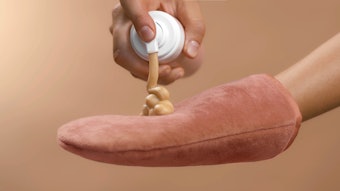
Gear clients up for spring break trips or summer by encouraging them to use adequate sun protection. You know who your bronze goddesses are; bust their bad summer habits to help deliver beautiful skin all year long.
1. Sunscreen is bad for you.
Why do people believe this? Some sunscreens contain oxybenzone, an ingredient that some studies have shown mimics estrogen, potentially causing cancer cells to grow more rapidly. However, there are no studies that prove that oxybenzone leads to cancer. In fact the American Cancer Society released a statement saying it “encourages the use of FDA-approved sunscreens,” which may include those with oxybenzone. For consumers who are still concerned, they can choose a sunscreen that does not contain oxybenzone–such as a physical sunscreen containing titanium dioxide or zinc oxide.
Zinc oxide and titanium dioxide are engineered into ultrasmall nanoparticles to make sunscreens more transparent, and there was no research to show if the tiny particles could penetrate the dermis and build up in the body, potentially causing DNA damage. However, studies have been published showing that these nanoparticles don’t absorb through the skin. Zinc oxide is actually a beneficial ingredient for your skin due to its anti-inflammatory, antibacterial, healing and antioxidant properties
Addressing the client. If the use of chemical sunscreens is a concern to a client, do not try to talk them into using it. You never know what someone has experienced; even the slight possibility of something causing cancer can be scary to some. In this case, it is better to just recommend physical sunscreen that is not micronized. Never talk a client into something they are wary of.
2. I tan because I need the Vitamin D.
Why do people believe this? UVB rays enable the skin to synthesize vitamin D, so by wearing an SPF 30 sunscreen that blocks almost 97% of the sun’s UVB rays, people believe they’re also blocking their ability to create vitamin D. However, research shows that normal use of sunscreen does not result in vitamin D deficiency. Not only do most people not apply enough sunscreen to stop the body from making vitamin D, but the body actually stops producing vitamin D after being in the sun for 15 minutes or so to prevent reaching toxic levels.
If someone is truly concerned with their vitamin D levels, they should have their doctor assess their vitamin levels and think about incorporating more vitamin D-rich foods (like salmon, cheese and fortified milk) into their diet. They can also ask their doctor about taking a vitamin D supplement.
Addressing the client. Simply describe that the risks of not using sunscreen can lead to skin cancer and the potential dangers that come along with it. There are also other ways to increase levels of vitamin D through certain foods and supplements if there is still concern.
3. I look healthier with a tan.
Why do people believe this? Tanning may have been popularized as early as the 1920s, when Coco Chanel went on vacation and returned home to Paris with tanned skin. The look sparked a trend and has only grown from there. Today, women believe tanning gives them a healthy “glow” and some even believe it makes them look thinner.
There’s no such thing as a healthy tan. Tanning ultimately leads to sun-induced pigmentation, wrinkles and an increased risk of skin cancer. Although the client may think they look healthy now, they won’t when all of the sun exposure from tanning has caused them to prematurely age and have deep wrinkles and sun spots.
Addressing the client. Simply explain that the immediate glow has severe long term effects and their skin will eventually be quite the opposite of glowing. Educate the client on the damage that the sun causes long-term. Using a wood’s lamp to show them what is going on beneath the skin is helpful, as well as showing pictures of healthy versus sun-damaged skin.
4. Tanning hides pigment and dries up my acne.
Why do people believe this? As tanning turns skin darker, any pigmentation spots on skin will appear less pronounced. They’re blending in with the darker shade skin produces after tanning. However, the sun does not actually lighten pigmentation spots, it just blends them in with tanned skin. The sun actually causes “sunspots,” or solar lentigines. In addition, many people with melasma (dense areas of pigment in the central third of the face) report that their pigmentation is worsened with sun exposure.
Tanned skin has a similar effect on acne as it does on pigmentation: when the skin is tan, acne spots are not as apparent. However, sunburn causes redness and leads to peeling, which may just aggravate the appearance of acne. UV light does have some antibacterial properties, so some people may believe that their acne lessens with sun exposure. However, there are too many effective and proven acne treatments to justify tanning to help acne.
Tanning to help acne is just trading one problem for many more. UVA and UVB exposure ultimately causes wrinkles, sagging skin, pigmentation and an increased risk for skin cancer. A more acceptable “light therapy” for acne is blue light LED therapy, which contains no UV rays and kills acne-causing bacteria.
Addressing the client. All skin conditions are exacerbated by inflammation, which is easily triggered by the sun. Although it seems as though it is helping, it will eventually intensify the condition we are trying to treat. This is a good time to teach camouflage makeup techniques to help the client feel better while going through the treatments.
5. It’s good to get a base tan before vacation.
Why do people believe this? When going to a tropical location close to the equator, where the sun’s rays are stronger, beachgoers know they’re likely to get sunburned. They believe that by getting a “base tan,” they’ll be afforded sun protection on their vacation. This is just not true. According to the U.S. Surgeon General and proven by many clinical studies, a base tan only provides an SPF of 3 or less. This is essentially meaningless in terms of sun protection.
A tan is the body’s response to damage from the sun. Tan skin = damaged skin. Period.
Addressing the client. Explain the above statistic and educate them on how to avoid sunburns. The use of sunscreen is essential and should be applied 30 minutes before going into the sun and then reapplied every 90 minutes. If they feel their skin burning for any reason, they should block their skin from the sun before it gets worse. Most resorts now have covered areas for those who are concerned.











